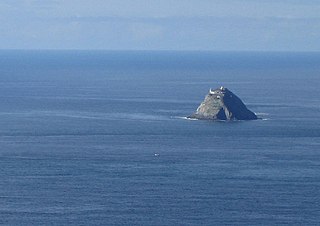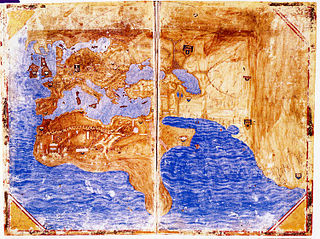
In Irish mythology, Donn is an ancestor of the Gaels and is believed to have been a god of the dead. Donn is said to dwell in Tech Duinn, where the souls of the dead gather. He may have originally been an aspect of the Dagda. Folklore about Donn survived into the modern era in parts of Ireland, in which he is said to be a phantom horseman riding a white horse.

Antillia is a phantom island that was reputed, during the 15th-century age of exploration, to lie in the Atlantic Ocean, far to the west of Portugal and Spain. The island also went by the name of Isle of Seven Cities.

In Celtic mythology, the Otherworld is the realm of the deities and possibly also the dead. In Gaelic and Brittonic myth it is usually a supernatural realm of everlasting youth, beauty, health, abundance and joy. It is described either as a parallel world that exists alongside our own, or as a heavenly land beyond the sea or under the earth. The Otherworld is usually elusive, but various mythical heroes visit it either through chance or after being invited by one of its residents. They often reach it by entering ancient burial mounds or caves, or by going under water or across the western sea. Sometimes, they suddenly find themselves in the Otherworld with the appearance of a magic mist, supernatural beings or unusual animals. An otherworldly woman may invite the hero into the Otherworld by offering an apple or a silver apple branch, or a ball of thread to follow as it unwinds.

José de Viera y Clavijo, was a Spanish, of Portuguese descent, Enlightenment ecclesiastic, poet, historian, botanist, ethnographer, and professor. He is best known for his exhaustive History of the Canary Islands, which took 20 years of work. He was assisted by Fernando de Molina Quesada, José Vandewalle, and others. The first volume was published in 1773, the second in 1774, the third in 1775, and the fourth in 1781. He recognized the Canaries as belonging to Africa and was a proponent of atlantonationalism. He recorded various expeditions from the Canaries in search of Saint Brendan's Island that occurred from 1487 to 1759. He investigated the influence of maritime activities in the Atlantic Ocean on the development of the islands. In this pursuit he also covered sailors such as Blas Zabala y Moreno, Francisco Díaz Pimienta, José Fernández Romero, José González Cabrera Bueno, and Tomé Cano. He was an admirer of Benito Jerónimo Feijóo y Montenegro and Voltaire, having been considered by scholarship after his time the "spiritual son" of the former.
Angelino Dulcert, probably the same person known as Angelino de Dalorto, and whose real name was probably Angelino de Dulceto or Dulceti or possibly Angelí Dolcet, was an Italian-Majorcan cartographer.

Abraham Cresques, whose real name was Cresques (son of) Abraham, was a 14th-century Jewish cartographer from Palma, Majorca, then part of the Crown of Aragon. In collaboration with his son, Jehuda Cresques, Cresques is credited with the authorship of the celebrated Catalan Atlas of 1375.

Portolan charts are nautical charts, first made in the 13th century in the Mediterranean basin and later expanded to include other regions. The word portolan comes from the Italian portolano, meaning "related to ports or harbors", and which since at least the 17th century designates "a collection of sailing directions".

The Isle of the Dead is a concept from pre-Christian Europe of an island to the west where souls went after death. It is reported as being part of Celtic belief by several Roman historians, and evidence for this belief is also found in Welsh folklore. It also existed in ancient Germanic traditions where the British Isles were sometimes depicted as the isles to the west that the dead inhabited.

"Majorcan cartographic school" is the term coined by historians to refer to the collection of predominantly Jewish cartographers, cosmographers and navigational instrument-makers and some Christian associates that flourished in Majorca in the 13th, 14th and 15th centuries until the expulsion of the Jews. The label is usually inclusive of those who worked in Catalonia. The Majorcan school is frequently contrasted with the contemporary Italian cartography school.
In Irish mythology, Éber Donn is the eldest son of Míl Espáine, the mythical ancestor of the Irish people. Unlike his brothers, Eremon, Éber Finn and Amergin, Éber Donn was unable to land in Ireland, and was killed by a shipwreck off the island's southwest coast. As reported by Lebor Gabála Érenn, Éber Donn slighted the goddess Ériu, who predicted that neither he nor his offspring would land safely on the soil of Ireland. He was buried by his brothers in Tech Duinn, a rocky island off the Irish coast.

Pietro Vesconte was a Genoese cartographer and geographer. A pioneer of the field of the portolan chart, he influenced Italian and Catalan mapmaking throughout the fourteenth and fifteenth centuries. He appears to have been the first professional mapmaker to sign and date his works regularly.
Gaillimh inion Breasail is the name of the mythical woman from whom the river and city of Galway, Ireland, derives its name.
Gabriel de Vallseca, also referred to as Gabriel de Valseca and Gabriel de Valsequa was a cartographer of Jewish descent connected to the Majorcan cartographic school. His most notable map is the portolan of 1439, containing the first depiction of the recently-discovered Azores islands.

Cartography throughout the 14th-16th centuries played a significant role in the expansion of the kingdoms of the Iberian Peninsula for a multitude of reasons. Primarily, the maps developed during this period served as navigational tools for maritime folk such as explorers, sailors and navigators. Mostly the expansion of the Crown of Aragon (which included the Kingdom of Aragon, Kingdom of Valencia and Kingdom of Majorca, together with the Principality of Catalonia, all its territories with seashore on the Mediterranean Sea. The Crown of Aragon controlled the routes across the Mediterranean Sea from the Kingdom of Jerusalem to Europe, as part of the commercial-trade route known as the Silk Road.
Domenico and Francesco Pizzigano, known as the Pizzigani brothers, were 14th-century Venetian cartographers. Their surname is sometimes given as Pizigano in older sources.

Zuane Pizzigano, was a 15th-century Venetian cartographer. He is the author of a famous 1424 portolan chart, the first known to depict the phantom islands of the purported Antillia archipelago, in the north Atlantic Ocean.
The Weimar map is an anonymous 15th-century Italian portolan chart, held by the Grand Ducal Library of Weimar. Although frequently dated as 1424, most historians believe it was probably composed a half century later. The author is unknown, although said to be a member of the Freducci family of cartographers of Ancona, most probably Conte di Ottomano Freducci. Faint and fragile, the Weimar map is rarely photographed and has been hard to decipher.

The Medici-Laurentian Atlas, also known simply as the Medici Atlas, is an anonymous 14th-century set of maps, probably composed by a Genoese cartographer and explicitly dated 1351, although most historians believe it was composed, or at least retouched, later. The atlas is currently held by the Biblioteca Medicea Laurenziana in Florence, Italy.

The Cornaro Atlas is an extensive Venetian collection of nautical charts and tracts, currently held in the Egerton Collection of manuscripts of the British Library.
Cogar is an Irish television documentary series, shown on the Irish language channel TG4. It focuses on people who have been "ignored" or are at the margins of society.


















